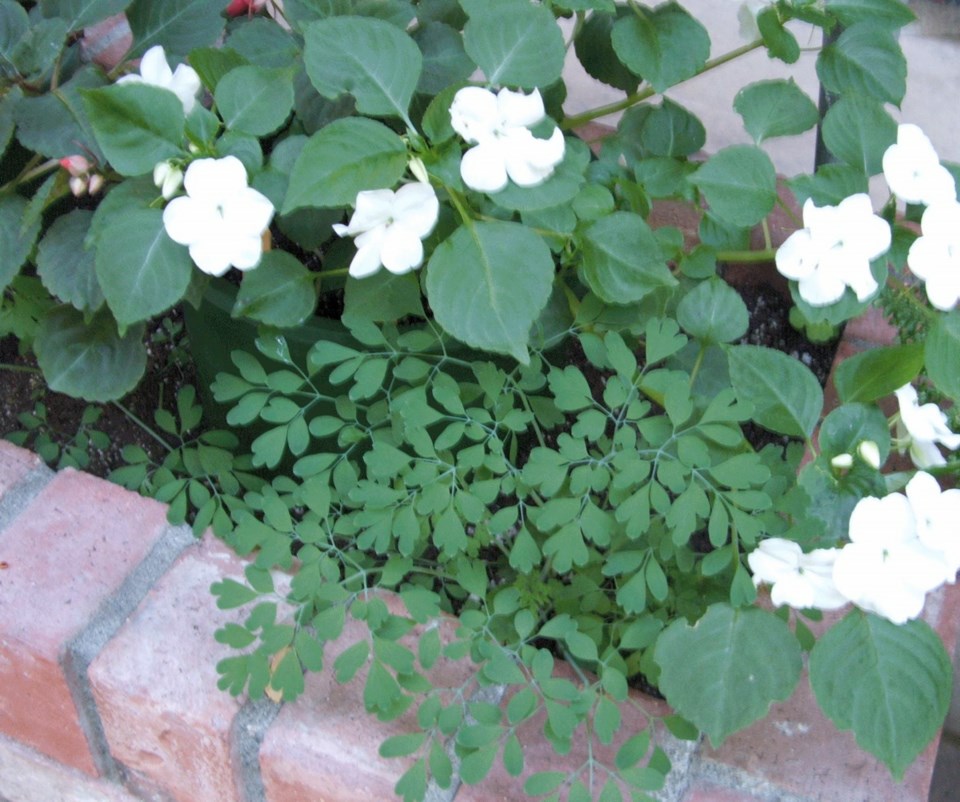I thought I’d discovered the secret of perpetual plant life when I found a wonderfully easy way to manage a long brick planter at the front of my home. No yearly spring planting. Just plucking up old plants in early spring and letting the self-sown seedlings grow.
For years now the planter has been filled with a species of corydalis (fumitory). These are low-growing and delicate looking, ferny-leaved perennials related to the more familiar bleeding heart (Dicentra).
I’d tried several corydalis varieties over the years. All of them died out in time, until I came across a seed catalogue listing for Corydalis ochroleucha.
The catalogue was either Chiltern Seeds or Plant World Seeds, both British seed houses that list this plant. C. ochroleuca persists, emerging even out of cracks in concrete.
Unwanted plants and seedlings lift up easily. Most often, they plant themselves where they are welcome.
My usual, very quick and easy spring routine at the planter is to pull up the large plants from the previous year, top the soil surface with a little fresh planting mix or fish compost, and water with a fine spray to allow the newly emerging plants to develop into another billowy line of ferny, flowering growth.
After that, all the planting needs is watering, which I do as I also water the begonia baskets hanging above the planter.
C. ochroleucha blooms from mid-spring through mid-autumn and often beyond. My plants are still full of fresh-looking foliage and crowded clusters of nodding, tubular, pale cream flowers with bright lemon lips.
With its wave after wave of freezing temperatures, last winter changed the usual front-planter routine somewhat. In most of its length, everything was the same, but in the less protected end, more exposed to winter cold and winds, the previous year’s plants died down and fewer seedlings emerged.
Luckily, I had the ideal temporary fill-ins for the bare spots — small flats of spreading Tumbler White and Tumbler Scarlet impatiens (Lindenberg Seeds).
I set one-gallon pots of alternating red and white impatiens into the planter at the bare end, and moved a few young corydalis clumps into the spaces between the pots to form a ferny underlay for the Tumbler plants.
The impatiens developed into broad, healthy plants filled with large, sparkling flowers.
Everything in the planter is still blooming vividly and, given a more usual winter, next year should bring a return to the normal, minimal-maintenance routine.
One of the best labour-reducing tactics available to gardeners is the use of easy and delightful, freely self-sowing flowers to create pockets of self-sufficient beauty in a landscape.
Some of my favourites among these “volunteer” flowers are peony poppies, larkspur, foxgloves, calendula and cosmos.
I recall one year when I never got around to planting a plot in a side area of the back garden.
Because of previous plantings there, that plot developed into a mass of bright yellow and orange calendula, tall peony poppies in many colours, and borage plants with their cucumber-scented leaves and small blue flowers that are lovely scattered on salads along with calendula petals.
Volunteer thugs
Not all self-sowing plants are welcome in home gardens. We can all think of weeds that let fly their seeds with alarming rapidity. Even some ordinary garden plants can become nuisances.
John Veillette wrote recently to note that “Some plants should come with warnings.”
He mentions seeing pots of colourful Chinese lantern plants this autumn. I’ve seen them too. They “can be a curse in a garden.”
It took me years to eradicate this plant from my garden. I’m still battling variegated goutweed (bishop’s weed, Aegopodium). It’s a spreading menace, suitable only for pots, if kept from forming seds.
Even sweet cicely and columbine can become thuggish invaders if not kept from shedding seeds. Digging up their long tap roots (even on fledgling plants) is tedious.
Garden events
Holiday wreaths and containers. Christmas wreath and container classes are already filling up at Russell Nursery, 1370 Wain Rd. in North Saanich. Wreath-making classes begin on Nov. 25 and 26 and run to Dec. 16. Holiday container and table-arrangement classes are on Friday, Dec. 15 at 1 p.m. and Sunday, Dec. 17 at 10 a.m. The $40 cost of the classes includes all materials. Details and registration at russellnursery.com.



